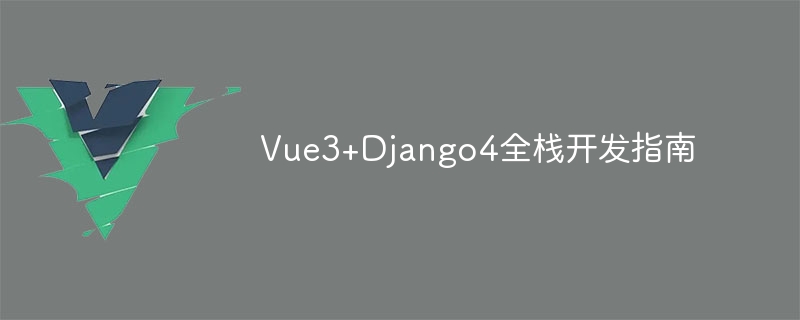Home >Web Front-end >Vue.js >Vue3+Django4 full stack development guide
Vue3+Django4 full stack development guide
- PHPzOriginal
- 2023-09-11 10:46:411105browse

Vue3 Django4 Full Stack Development Guide
With the popularity of the front-end and back-end separation development model, Vue and Django have become the technology stacks favored by many developers. As a popular front-end framework, Vue is easy to learn, flexible and efficient, while Django is a powerful back-end framework that provides various functions needed to develop web applications.
The recently released Vue3 and Django4 bring many exciting new features and improvements, improving development efficiency and user experience. This article will lead readers to understand the full-stack development guide for Vue3 and Django4, helping developers better utilize these two frameworks for full-stack development.
Step one: Set up the environment
Before starting full-stack development, we first need to set up a development environment. Vue3 requires Node.js as the running environment, while Django4 requires Python support. Therefore, we need to install Node.js and Python separately.
Installing Node.js is very simple. Download the corresponding installation package from the official website, and then install it according to the prompts. After the installation is complete, we also need to install Vue's scaffolding tool vue-cli, which can be installed through the following command:
npm install -g @vue/cli
Installing Python is also very simple. You can download the corresponding installation package from the official website, and then install it according to the prompts. That’s it. After the installation is complete, we also need to install Django and related extension packages. You can use the pip command to install:
pip install Django
Step 2: Create a Vue3 project
After setting up the development environment, we You can start creating a Vue3 project. Open the command line terminal and use the following command to create a new Vue3 project:
vue create my-project
Then configure the options according to the prompts. You can choose manual configuration or default configuration. After choosing manual configuration, you can choose various features and plug-ins according to your needs.
After creating the project, enter the project directory and use the following command to start the development server:
cd my-project npm run serve
In this way, you can access the project in the browser and see the Vue3 welcome page.
Step 3: Create a Django project
Next, we need to create a Django project. In the command line terminal, use the following command to create a new Django project:
django-admin startproject mysite
After creating the project, enter the project directory and use the following command to start the development server:
cd mysite python manage.py runserver
This way you can Access the Django welcome page in the browser.
Step 4: Connect Vue3 and Django
Now that we have a Vue3 project and a Django project, we need to connect them. First, we need to configure the proxy in the Vue3 project to be able to access Django's API. Create a vue.config.js file in the root directory of the Vue3 project, and then add the following configuration:
module.exports = {
devServer: {
proxy: {
'^/api': {
target: 'http://localhost:8000',
ws: true,
changeOrigin: true
}
}
}
} Then, when making API requests using axios or other HTTP client libraries in the Vue3 project, you can access it directly /apiPath.
In the Django project, we need to create an API view to handle the requests sent by Vue3. You can create an api.py file in which you write the logic of the API view. For example, you can use Django's rest framework to quickly create a RESTful API:
from rest_framework.decorators import api_view
from rest_framework.response import Response
@api_view(['GET'])
def hello_world(request):
return Response({'message': 'Hello, World!'})Then, add the route of this API view in the urls.py of the Django project:
from django.urls import path
from . import api
urlpatterns = [
path('api/hello', api.hello_world),
] In this way, when in Vue3 When sending a GET request to /api/hello in the project, Django will return a JSON response containing {'message': 'Hello, World!'}.
Step 5: Develop application functions
After the above steps, we have successfully connected Vue3 and Django and can send API requests in Vue3. Next, we can start developing application functions according to our needs.
In a Vue3 project, you can use Vue3's new features such as Composition API to write component logic. You can use Vue Router for front-end routing management and Vuex for state management.
In a Django project, you can use Django's models and database migrations to define and manage data models. You can use Django's forms and templates to handle user input and render the interface.
Step Six: Deployment and Optimization
The last step is to deploy and optimize our application. You can use Vue3's packaging command to compile the front-end code into a static file and then deploy it to the server.
For Django projects, you can use Django's built-in development server for testing and debugging, and then consider using Nginx uWSGI for deployment.
In addition, front-end and back-end code can be optimized to reduce loading time and improve performance. You can use Webpack and Babel to optimize Vue3 projects, and use Django's caching and performance tuning tools to optimize Django projects.
Conclusion
This article introduces the Vue3 Django4 full-stack development guide, hoping to help readers better utilize these two frameworks for full-stack development. Vue3 and Django4 provide rich functions and powerful tools, making full-stack development simpler and more efficient. We hope that readers can skillfully use these two frameworks during the development process and create more outstanding applications.
The above is the detailed content of Vue3+Django4 full stack development guide. For more information, please follow other related articles on the PHP Chinese website!
Related articles
See more- About vue using validator: VeeValidate3
- What are the differences between computed and method in Vue?
- Introduction to the method of turning off Eslint verification in the vue project
- Introduction to several methods of defining component templates in Vue.js
- Four places to implement AJAX in Vue applications

